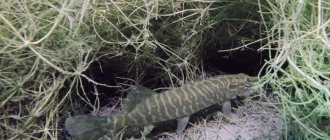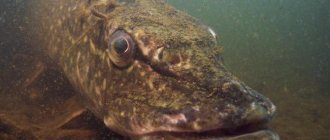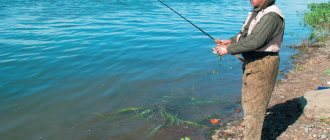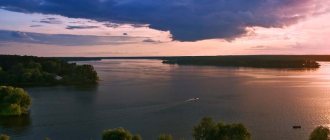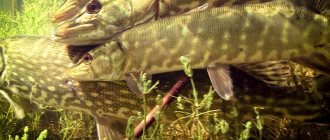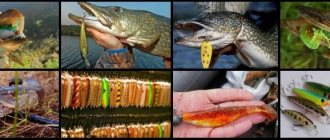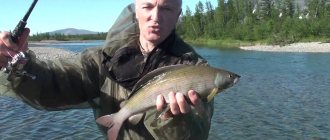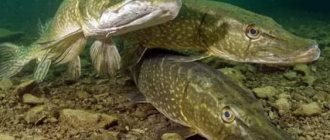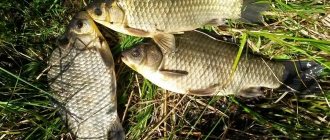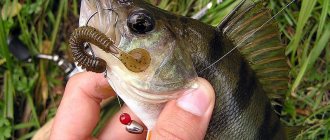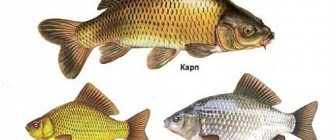Distribution and habitats of pike
Pike lives only in freshwater bodies of water or in desalinated parts of the seas. Found in the Northern Hemisphere (Eurasia, North America). Spotted fish prefers low-flowing or stagnant waters. A suitable parking lot must meet a number of requirements:
- sandy bottom;
- presence of aquatic vegetation;
- edges, pits;
- flooded snags and trees;
- Differences in depth are desirable.
Pike does not live in mountain rivers with fast currents and rocky bottoms due to the impossibility of setting up an ambush here. Also, the spotted one does not like small ponds, which “bloom” in the summer and are completely covered with ice in the winter.
Typical habitats are small and large rivers, lakes, ponds, reservoirs and other artificially created reservoirs. As an exception, you can meet grass pike even in some swamps. Preferred stopping places for the spotted fish are floodplain lakes, river beds and bays.
How to get up?
The spinner, ideally, should be positioned on the shore slightly above the fishing spot. You should pay attention to small shoreline ledges that allow you to cast at a “zero angle.” It is desirable that the shore be convenient for fishing. This is quite an important point and cannot be ignored. I remember a couple of years ago, having chosen not the best position for casting and standing almost on one leg, I sent the bait directly to the coastal dump, access to which was blocked by abundant bushes and tall grass. No sooner had the weight touched the bottom than a powerful bite almost tore the spinning rod out of my hands. The pike landed at 5-6 kg. Having dragged it for about 30 meters, I thought about how to pull it out? There are bushes all around, a snag in the center, and I’m standing on one leg. The pike, taking advantage of my confusion, came to the “candle”, and all my “problems” were solved by themselves. Fish in the river, me with a loose tackle in my hand.
Where to look for pike
Promising places for pike to stay differ for each specific body of water. The fisherman needs to know and take into account the hydrological features of the selected water area.
In a river
Pike set up ambushes in the most hidden and protected places. These are aquatic plants, fallen trees, snags or single boulders along the shoreline.
Typical habitats of pike on the river:
- steep coastline with depth changes;
- deep hole - a junction of two or more rivers;
- the area immediately behind the dam.
You can find pike on the river in other, most unpredictable places. Changes in weather conditions and surges in atmospheric pressure force the spotted fish to migrate across the water area.
On small rivers
If the bed of a small river has a minimum depth of 1-1.5 m and small fish (bleak, roach) are found here, pike lives in this reservoir. But the shallower the river, the more careful the pike. A fisherman in such waters must exercise maximum camouflage and caution.
About
Features of lake and river pikes
Pike in different bodies of water have certain differences; lake and river pike will differ visually and even very much from each other. The main differences can be presented in the following table:
| river pike | lake pike |
| elongated body | shorter body |
| large head | smaller head |
| paler color | brighter scales |
But in all other respects the predators will be absolutely identical. They often react when fishing with the same baits; a catchy wobbler will work equally well in the river and in still water.
What time of day is best to catch pike?
Each individual population living in a specific water area develops its own biological rhythm of existence. For example, in one lake the predator actively bites before dawn, in another - before sunset. Therefore, all of the above recommendations are general; they may vary for each specific body of water.
| Times of Day | Peculiarities of biting |
| Dawn (early morning) | The pike “wakes up” and sets up an ambush as early as 4-5 o’clock in the morning. An additional advantage for the fisherman is poor lighting (it is difficult for fish to distinguish live fish from bait). The chances of catching a large specimen are highest in the morning. |
| Daytime hours | In good sunny and clear weather, the bite is completely exhausted by noon. The predator accurately sees its real victim; it does not attack artificial baits. On a gloomy, cloudy day and drizzling rain, you can fish during the day, since visibility in the water is significantly deteriorated. |
| Evening time | If the bite has been stopped, it will resume only at 18-19 hours. From 19 to 22-23 increased activity of the predator remains. |
| Night | After midnight the pike does not bite. This is due to the fact that small fish (the main food source of the predator) have stopped all their movements in the reservoir. |
There is pike, but it doesn’t eat!
Often, pike in the coastal zone make their presence known by splashes and breakers in pursuit of fry. Here you no longer have to guess whether there is a predator in this area or not. As a rule, a few casts into the splash zone and the pike ends up on the shore. There are times when pike and fry are constantly chasing near the shore, but do not want to take the bait. It was a rainy June of 2000. Having caught pike perch in one of the fishing spots, I decided that returning home without a pike was somehow out of the question. I chose a familiar bay with bushes growing along the banks. I stood at a familiar point and began casting along the coastline. Literally 10 meters from me, a pike kept chasing the fry, sometimes jumping high out of the water. What did I do to catch her? I tried all kinds of wiring and baits, but to no avail. For about twenty minutes I tried to “seduce” the intractable pike and in the end I decided to “give up” on this matter. He walked a few meters forward and made an accurate throw directly under the opposite shore of the bay. Before the bait had time to touch the bottom, a bite followed, and the long-awaited pike was caught. And the previous one - the one he was hunting for - continued to chase the coastal fry.
The influence of weather on pike biting
When planning a fishing trip, be sure to take into account the weather forecast. Under unfavorable conditions, the bite may be completely absent, as the fish will leave its usual places and hide.
In what weather does pike bite better?
Suitable weather conditions depending on periods and months.
- From January to April – fishing will be successful on sunny and clear days.
- Mid-May-June – pike have a seasonal feeding period and are quite active in any weather.
- July August. The worst weather for pike is sunny afternoon. The bite intensifies only after the heat of the day subsides (evening, morning).
- Late September-October, November – fishing will be successful in cloudy weather and light drizzle with moderate wind.
- December-January – the weather “doesn’t matter”.
At what pressure does pike bite best?
Optimal indicators are stability and constancy, absence of jumps and drops. It does not matter what kind of pressure, high or low. If the pressure is relatively stable for 3-4 days, fishing success is guaranteed.
At what water temperature does pike bite?
Pike is a fairly “cold-resistant” fish. It is perfectly adapted to low temperatures; the spotted one tolerates the summer heat much worse. Optimal temperatures vary from -7 – -5 to +15 – +20.
Wintering and summer camping areas
Whatever the habitat of the pike, in the heat and winter it chooses more suitable places with appropriate conditions. It is worth understanding that pike does not hibernate either in winter or in summer, it only becomes less active.
To find a toothy predator in a pond, you need to know the following subtleties depending on the season:
- In winter, in cloudy weather with constant pressure and moderate frost, pike stop at wintering pits. It is here that she will find everything she needs to survive. Small fish periodically come out to feed, thereby getting caught by the pike. The toothy predator does not come out to the shallows at all in water bodies under ice.
- The predator's summer stopping places are determined by weather conditions; when it's hot, you should look for pike near deep holes, in the grass and coastal thickets. It is in these places that the temperature will be lower than in the middle of any body of water.
It is impossible to say exactly where the pike is found in spring and autumn; during the feeding season, it can migrate in search of food or stand in one place.
It is not so difficult to recognize the habitats of pike; the main thing is to know the seasonal habits and preferences, then it will not be at all difficult to find the predator.
Seasonal features
| Winter | At the beginning of the season, pike still retain moderate activity and mobility. The fish does not want to waste energy and bites almost immediately. In the depths of winter, pike live in the depths and hide there; fishing comes to a standstill. Towards the end of winter, the activity of the spotted fish begins to gradually revive, and the pike goes hunting. |
| Spring | After the ice melts, the pike goes to spawn. During spawning, individuals are inactive and lethargic, making them difficult to catch. After spawning, there are 14 “golden” days, when the pike begins to eat, it bites on everything indiscriminately. |
| Summer | Fishing is extremely difficult. Pike is capricious and picky. The predator goes into the depths and almost completely loses its appetite. In summer it is extremely difficult to guess with bait. |
| Autumn | The best time to hunt pike. After the heat subsides, the glutton for fat gain begins (preparing for the coming winter). Pike hunt intensively, and the chances of catching large specimens are high. |
Sand spits
It is preferable to fish on shallow spits in the morning and evening hours, since predators most often follow the spits during these hours. This happens because at this time there are always a lot of smaller fish there, which actively feed here. Often the duration of active biting can be very short - approximately 45-60 minutes. But thanks to the high concentration, pike fishing in the river at this time is especially productive. In a short period of time you can catch more than a dozen predators.
Read! Technique for catching pike with mugs
On big lakes
Let's say you find yourself on a large lake. For one, a large lake is a reservoir of several hectares; for another, it is a reservoir with no visible other shore. I belong to the latter category of fishermen. Regardless of which category you fall into, you need to make it easier for yourself to find pike in a large reservoir. To do this, it is necessary to conditionally break it into several parts. A completely unfamiliar lake must first be studied on a map, selected a promising area, and made notes. The selected area of a large lake is best explored by boat, although even using a map you can determine the most promising parts of the island. For example, lakes formed during the Ice Age in Scandinavia, Canada, North America and parts of Ireland have the same shape and are located from north to south. Numerous islands in these lakes also have a similar structure. Glaciers usually move from north to south. In nine out of ten cases, there is depth on the northern side of these islands, and shallow water on the southern side, which gradually turns into depth. These small areas, characterized by distinct structural elements and the presence of benthic aquatic vegetation, are where I concentrate my attention.
In nine out of ten cases, fishing on the north side is a waste of time, but there may be pike on the south side of the island. The same thing happens with underwater structural elements or, in other words, underwater islands. As a rule, the northern side of such an island will be shallow, and the southern side will be deep. The fish feel safe if the shallow water smoothly turns into depth, otherwise you should move to the north side. In most cases, finding fish will not be difficult. On a detailed map, you can find elongated islands, followed by a smooth drop to depth. In such places you will certainly find fish!
Look for structural features near the shore: humps, piles of rocks, ledges, etc. You can find a large number of these areas in one lake. Concentrate on those that are surrounded by a dense carpet of bottom vegetation. Stones and rocks also attract a predator, and if stones or rocks border an area with underwater vegetation, then you have found a promising place. Having caught one pike in one place, you should not immediately change it, because there can often be several predators there at once.
I prefer to catch pike with jerk baits, such as Slider, for example, or I use a Twinler silicone bait. These are universal baits that work effectively at depths of up to four to five meters. In small areas covered with vegetation, I use surface wobblers. Try these wonderful lures, enjoy their game and unforgettable sensations while fishing for pike.
Pike lifestyle.
Pike prefer to live alone. This fish is not afraid of anyone or anything. She is not afraid of either the shadow of a bird flying over the water, or the shadow of a fisherman. She sees her rival in any large living object and can monitor him for a long time.
And although pike is considered a sedentary fish that leads a sedentary lifestyle and does not like long distances, it still has its own hunting route. It is a closed loop that covers all the places where you can set up an ambush for hunting. These can be various holes, algae bushes, and snags.
The movements of the pike are agile and fast, but it prefers to grab its prey from ambush or by resorting to certain tricks. For example, it lifts silt from the bottom with its tail. The resulting turbidity shields the insidious predator from the fish swimming nearby.
Pike is a diurnal fish. It usually feeds in the morning and late afternoon. He usually rests during the midday hours. At night he sleeps.
